Laser Engineering and Spectroscopy on Graphene and Related 2D Materials
2D Materials
Abstract:
The research topic aims at the Investigation and Engineering of the optoelectronic properties of two-dimensional (2D) materials.
Two-dimensional Transition Metal Dichalcogenides MX2 (M=Mo, W and X=S, Se, Te) are of keen interest for emerging optoelectronic and valleytronic applications. The main activities in our lab focus on the optical response of 2D layered materials and their heterostructures. Spectroscopic techniques such as μ-PL, μ-Reflectance, and Raman are used to characterize the samples from 4K to 300K. We investigate how the degree of valley polarization (VP)-under resonant and non-resonant conditions-is affected by the dielectric environment in different heterostructures such as MX2/h-BN, MX2/Graphene, as well as their corresponding encapsulated structures. Besides, a fast-photochemical doping technique was developed in our lab to sufficiently control the carrier density of a single MX2 layer by incorporating chlorine atoms on the surface. Photochlorination leads to a controllable modification of VP that is directly related to the total number of the active defect sites and consequently to the control of the non-radiative exciton lifetime. We also study the PL emission and VP of suspended MX2 in different configurations with respect to strain induced by patterned substrates. Suspended MX2 monolayers (near zero strain) display enhanced PL and absorption due to the absence of charged excitons.

Spectroscopy of 2D materials provide the principal knowledge towards the development of state-of-the-art optoelectronic and valleytronic devices.
Research topics:
- Fabrication of Graphene and other 2D materials
- Spectroscopy of 2D materials and their heterostructures
- Photochemical doping of Graphene and other 2D materials
- Optoelectronic properties of TMDs at different dielectric environments
- Transient Absorption Spectroscopy of 2D materials
Highlights:
- Spatially selective reversible charge carrier density tuning in WS2 monolayers via photochlorination
- Tunable charge carrier concentration of chlorine doped 1L-WS2
- The effect can be reversed upon continuous wave laser scanning of the monolayer in air
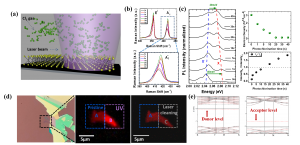
(a) Schematic representation of the process used for the photochlorination of TMDs. (b) Evolution of the Raman Spectra of WS2 monolayer with the photochlorination time shown in the inset; evolution of the out-of-plane vibrational mode A’1 (c) Evolution of the PL spectra of a 1L-WS2 at 78 K, with the photochlorination time. Evolution of the calculated electron density with the photochlorination time and the ratio of normalized intensities of the X and X− peaks as a function of the photochlorination time. (d) Reversal of the photochlorination effect upon CW laser rastering of the chlorine-doped area, indicated by the suppresion of the PL emission by the area assigned as C. (e) Electronic band structures of 1L-WS2 with Chlorine atoms filling S vacancies (left panel), with Chlorine atoms adsorbed on the basal plane (right panel).
I.Demeridou, I. Paradisanos, Yuanyue Liu, N. Pliatsikas, P. Patsalas, S. Germanis, N. T. Pelekanos,
W.A. Goddard III, G. Kioseoglou and E. Stratakis, 2D Materials 6.1 (2018): 015003.
- Tuning the valley polarization in WS2 monolayers with photochemical doping
- Controlled valley polarization via modifying the electron densities in the crystal lattice of chlorine doped 1L-
- Reduction of circular polarization is directly related to the increase of the non-radiative exciton lifetime (τNR) – Elimination of the defect sites in the crystal lattice
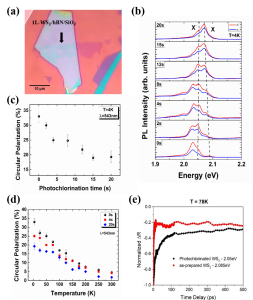
(a) Optical image of WS2/hBN (b) PL spectra at 4K excited with 543nm laser for different photochlorination times analyzed for σ+ (red) and σ- (blue) helicity. (c) Circular polarization as function of the photochlorination time at T=4K. (d) Temperature dependence of the circular polarization for the neutral exciton for the pristine sample (black points) and for photochlorination times 4s (red) and 20s (blue). (e) Transient Absorption spectra of the A-exciton for the photochlorinated WS2 (black) and the as-prepared WS2 (red) at 78K.
I.Demeridou, A. Papadopoulos, G. Kourmoulakis, L. Mouchliadis, E. Stratakis, & G. Kioseoglou, Applied Physics Letters 118.12 (2021): 123103.
- Prominent room temperature valley polarization in WS2/Graphene heterostructures grown by chemical vapor deposition
- The degree of valley polarization of WS2 is considerably influenced by the material type used to form the heterostructure.
- The interaction between WS2 and Graphene has a strong effect on the temperature dependent depolarization
- The observed low depolarization rate in the WS2/Gr heterostructure is attributed to the nearly temperature independent scattering rate
- Significant variations in the degree of polarization are also observed at 4K between the different heterostructure configurations
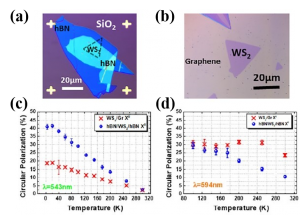
(a) Optical images of hBN/WS2/hBN and (b) WS2/Gr. (c) and (d) T-dependent valley polarization for X0 of hBN/WS2/hBN and WS2/Gr under 543 and 594 nm excitation, respectively.
I.Paradisanos, K. M. McCreary, D. Adinehloo, L. Mouchliadis, J. T. Robinson, Hsun-Jen Chuang, A. T. Hanbicki, V. Perebeinos, B. T. Jonker, E. Stratakis, and G. Kioseoglou, Applied Physics Letters 116.20 (2020): 203102.
- Room temperature observation of biexcitons in exfoliated WS2 monolayers
- We report on the existence of biexcitons in mechanically exfoliated WS2 flakes from 78K up to room temperature
- Performing temperature and power dependent PL measurements, we identify the biexciton emission channel through the superlinear behavior of the integrated PL intensity as a function of the excitation power density
- Neutral and charged excitons show a linear to sublinear dependence in the whole temperature range. From the energy difference between the emission channels of the biexciton and neutral exciton, a biexciton binding energy of 65–70meV is determined
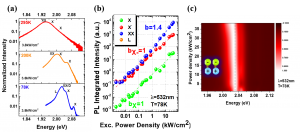
(a) Temperature-dependent PL spectra under 3.8kW/cm2 excitation power density. (b) Integrated PL intensity of L, XX/D, X–, and X peaks for different excitation densities. The XX/D peak exhibits a superlinear relationship with a power law exponent of 1.4 for excitation densities higher than ~1 kW/cm2. (c) 3D plot showing the emission strength of the XX/D at different excitation densities, at 78K. With increasing the excitation power density the biexciton emission dominates the spectra.
I.Paradisanos, S. Germanis, N. T. Pelekanos, C. Fotakis, E. Kymakis, G. Kioseoglou, and E. Stratakis,
Applied Physics Letters 110.19 (2017): 193102.
- Spatial Non-Uniformity in Exfoliated WS2 Single Layers
- Spatial variation of exciton complexes across the surface of monolayers
- Neutral excitons and trions competition due to the presence of oxygen species
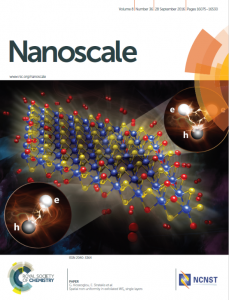
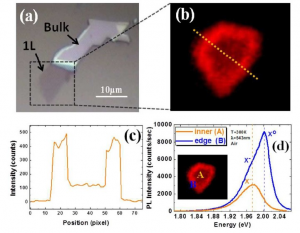
(a) Typical optical microscopy image of exfoliated WS2 flakes. (b) Fluorescence image of WS2 monolayer. The stronger PL emission originates from the edges, creating a “donut” effect. (c) Intensity profile across the flake, following the line scan of Fig. 1b. (d) PL spectra comparison of two different spots on the flake (inset of Figure 1d). The PL emission from the central area is dominated by charged exciton (trion) recombination (X–, at 1.97eV) while the emission from the edges is mainly due to the neutral excitons (X0 at 2.01eV).
I.Paradisanos, N. Pliatsikas, P. Patsalas, C. Fotakis, E. Kymakis, G. Kioseoglou and E. Stratakis, Nanoscale 8.36 (2016): 16197.
6.Suspended and Strained areas on a single monolayer WS2flake
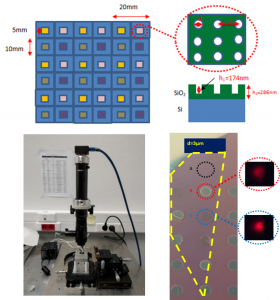
- Realization of a control method to create suspended and strained areas on a single flake
- Full spectroscopic characterization (Raman, PL, Spin-Valley polarization and Reflectivity) is utilized to study the system
- Neutral excitons dominate the photoluminescence from the suspended areas in combination with decreased spin-valley polarization, attributed to reduced carrier density
- Towards realization and fabrication of multifunctional devices utilizing a single TMD layer
Collaborators
- Vasili Perebeinos, Department of Electrical Engineering, SUNY at Buffalo NY, USA
- Aubrey Hanbicki, Laboratory for Physical Sciences, University of Maryland, USA
- Kathleen M. McCreary, Naval Research Laboratory, USA
- John Parthenios, Principal Staff Scientist, FORTH/ICE-HT, Greece
- Konstantinos Papagelis, Department of Physics, Aristotle University of Thessaloniki, Greece
- Panos Patsalas, Department of Physics, Aristotle University of Thessaloniki, Greece
- Joe Christodoulides, Naval Research Laboratory, Washington, D.C
Publications
- Tuning the valley polarization in WS2 monolayers via control of active defect sites induced by photochemical doping
I.Demeridou, A. Papadopoulos, G. Kourmoulakis, L. Mouchliadis, E. Stratakis, & G. Kioseoglou, Applied Physics Letters 118.12 (2021): 123103.
- Prominent room temperature valley polarization in WS2/Graphene heterostructures grown by chemical vapor deposition
I.Paradisanos, K. M. McCreary, D. Adinehloo, L. Mouchliadis, J. T. Robinson, Hsun-Jen Chuang, A. T. Hanbicki, V. Perebeinos, B. T. Jonker, E. Stratakis, and G. Kioseoglou, Applied Physics Letters 116.20 (2020): 203102.
- Spatially selective reversible charge carrier density tuning in WS2 monolayers via photochlorination
I.Demeridou, I. Paradisanos, Yuanyue Liu, N. Pliatsikas, P. Patsalas, S. Germanis, N. T. Pelekanos,
W.A. Goddard III, G. Kioseoglou and E. Stratakis, 2D Materials 6.1 (2018): 015003.
- Room temperature observation of biexcitons in exfoliated WS2 monolayers
I.Paradisanos, S. Germanis, N. T. Pelekanos, C. Fotakis, E. Kymakis, G. Kioseoglou, and E. Stratakis,
Applied Physics Letters 110.19 (2017): 193102.
- Spatial Non-Uniformity in Exfoliated WS2 Single Layers
I.Paradisanos, N. Pliatsikas, P. Patsalas, C. Fotakis, E. Kymakis, G. Kioseoglou and E. Stratakis, Nanoscale 8.36 (2016): 16197.
- Intense Femtosecond Photoexcitation of bulk and monolayer MoS2
I.Paradisanos, E. Kymakis, C. Fotakis, G. Kioseoglou, and E. Stratakis, Appl. Phys. Lett., 105 (2014), 041108.
Project Members
Prof. George Kioseoglou & Dr. Emmanuel Stratakis
Dr. Sotiris Psilodimitrakopoulos
Dr. Leonidas Mouchliadis
Dr. Ioanna Demeridou
Mr. Antonis Papadopoulos
Mr. George Kourmoulakis
Ms. Eirini Katsipoulaki
Mr. George Maragkakis
Dr. Ioannis Paradisanos (Alumni)

